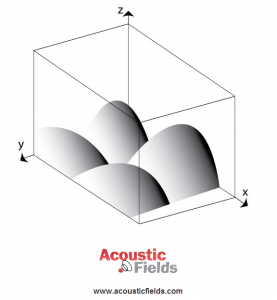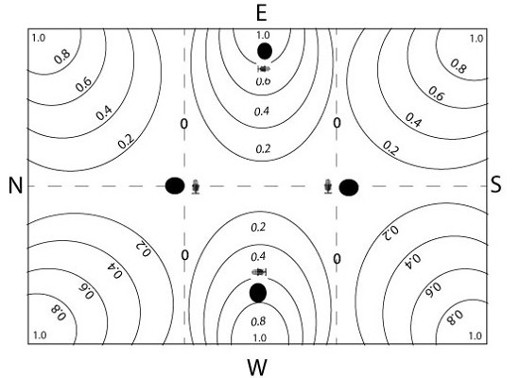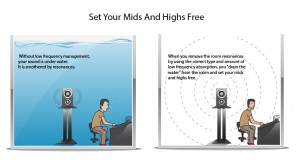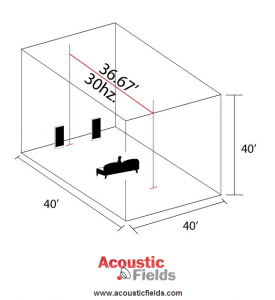Renew Your Room Acoustics, Part 1: Waves and Pressure
The energy that we put into our listening rooms, home theaters, and professional recording studios comes in two main forms. We have waves of energy and we have rays. For purposes of this discussion and illustration, we will label all room energy that is below 300 Hz. as waves and all energy that occurs within our rooms and that energy that occurs above 300 Hz. as rays.
Waves And Rays
Waves and rays have different forms. Waves of sound energy are just like ocean waves. They are long, tall, and thick and act similar to ocean waves. Waves move through our rooms with peaks and valleys, just like ocean waves. They move in cycles and rise and fall against our room surfaces just like waves crashing upon a beach. Rays are shorter, smaller, and more straight line in travel. You can think of the energy within our rooms that occurs over 300 cycles as similar in nature to rays of sun light.

Sound Pressure Vs. Reflections
There are two main acoustical paradigms that you must understand if you are going to learn how waves and rays move within your room: sound pressure and boundary reflections. Waves form the basis and foundation of the sound pressure within our rooms.
Since waves are long, most will not fit into today’s small rooms: a 30 Hz. wavelength is around 37′. You don’t see this room dimension too often when working with client’s rooms. When they don’t fit, and most don’t, they express their discomfort in many ways.
Rays / Reflections
Rays contribute directly to reflections. Since rays are smaller and shorter, they strike our room boundary surfaces and then dart back and forth throughout the room striking as many surfaces as their energy levels will permit. These reflections take on a sonic signature of their own and add what we call “room sound”. It is always that delicate balance between room sound and the direct or near field sound from our speakers that we try to achieve. Lets first look at sound pressure and its impact upon our room sound.
Waves / Pressure
Waves of energy that fall below 300 Hz. are long in length. Most energy below 100 Hz. does not fit well in today’s small rooms. A 100 Hz. wave is 11′ in length and even this frequency can be problematic in today’s small rooms. Waves of energy start from our source and travel through the room.
At these lower frequencies they travel through the room, the walls, and even into the next rooms. They are like bulls but they are in your room, not a china shop.
Trapped Air
When they reach a room dimension, say between the ceiling and floor that they do not like, they begin to resonate. The air space between the two physical dimensions takes on a life of its own and starts to move. This trapped energy accumulates and “loads” into a particular room location.
Frequencies that happen to find their way into these “vortexes” may be heard or may not. It depends on the “phase” of the mode. Those frequencies that are heard may be exaggerated in strength, others will appear to have fallen into a black hole and not be heard from again.
To show how powerful these modes or pressure areas can be, you will blow your EQ up, before you will make any sonic improvement by trying to add that “missing” energy that the mode has captured and taken hostage.
Pressure Variance
Wavelengths react differently in each room location. Since there are many frequencies that comprise waves, we have many ratios of room dimensions that will not be a good fit for most. You can have a 40 Hz. room modal issue in one part of your room and have a 80 Hz. modal pressure area in another part.
The length of any given frequency will react differently in room locations that are too small for the lower frequency energy to move around in. These situations occur throughout the room space.
Highs And Lows
These pressure areas within our room look like a meteorological map of high and low pressure areas. We have greater pressure areas that reside against the walls or room boundary surfaces. The strength of each of these areas has many levels. The pressure can reduce as you move away from the room boundary surface towards the room center.
These differences can have magnitudes of plus or minus 15 dB. In a rectangular room, these pressure areas are consistent in strength and position. In a non-uniform shape, they can be everywhere.
Middle Frequencies
When your middle frequencies find themselves in one of these pressure areas, they are like the cow that gets picks up from the field and spun around inside the tornado. They have to migrate through all of this uneven pressure distribution. Some frequencies will survive the journey, others may never be heard from again. All this occurs or does not within the small confines of your room and in real time.
Pressure Chamber
If we view our room as a pressure chamber, where we have many waves of different lengths trying to find a fit into the room dimensions, we will find some that fit but most do not.
It is this dynamic interplay of continually fluctuating pressure areas throughout our rooms, that we must spend more time studying and understanding because the room distortions produced are just too destructive to our quality sound efforts no matter what the room usage is. Low frequency room modes can literally smother middle frequencies to the point you will never hear them.
Parts: 2 – 6
In Part Two of this series on Waves and Rays, we will discuss rays and their contribution to reflections. In Part Three, we will examine the technologies currently available for low frequency pressure management and in Part Four, we will examine middle and high frequency absorption technologies that minimize reflections from our room boundary surfaces. Parts 5 and 6 will discuss the application and positioning of these technologies for maximum sound quality.
Dennis Foley is the Chief Acoustic Engineer at Acoustic Fields with over 30 years experience in the business. His technology has been used in Electric Lady Land Studios, Sony Music of New York, Cello Music and Films founded by Mark Levinson, and Saltmines Studios in Mesa, Arizona, along with hundreds of others. If you would like to learn more about room acoustics then be sure to subscribe to his YouTube channel for access to all his training videos and tutorials.
Please note: When you buy products through links on this page, we may earn an affiliate commission.











Glenn Brown
October 9, 2014 at 6:26 pm (11 years ago)Very good like being back in recording school 22 years ago